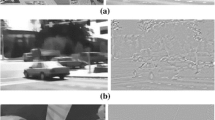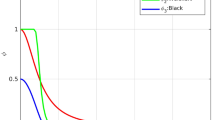Abstract
The primary goal in motion vision is to extract information about the motion and shape of an object in a scene that is encoded in the optic flow. While many solutions to this problem, both iterative and in closed form, have been proposed, practitioners still view the problem as unsolved, since these methods, for the most part, cannot deal with some important aspects of realistic scenes. Among these are complex unsegmented scenes, nonsmooth objects, and general motion of the camera. In addition, the performance of many methods degrades ungracefully as the quality of the data deteriorates.
Here, we will derive a closed-form solution for motion estimation based on thefirst-order information from two image regions with distinct flow “structures”. A unique solution is guaranteed when these corespond to two surface patches with different normal vectors. Given an image sequence, we will show how the image may be segmented into regions with the necessary properties, optical flow is computed for these regions, and motion parameters are calculated. The method can be applied to arbitrary scenes and any camera motion. We will show theoretically why the method is more robust than other proposed techniques that require the knowledge of the full flow or information up to the second-order terms of it. Experimental results are presented to support the theoretical derivations.
Similar content being viewed by others
Explore related subjects
Discover the latest articles, news and stories from top researchers in related subjects.References
Adiv, G. 1985a. Inherent ambiguities in recovering motion and structure from a noisy flow field,Proc. Conf. Comput. Vis. Patt. Recog., San Francisco, June.
Adiv, G. 1985b. Determining 3-D motion and structure from optical flow generated by several moving objects,IEEE Trans. Patt. Anal. Mach. Intell. 7(4).
Aloimonos, J. and Basu, A. 1986. Determining the translation of a rigidly moving surface, without correspondence,Proc. Conf. Comput. Vis. Patt. Recog., Miami, FL, June.
Aloimonos, J., and Brown, C. 1984. Direct processing of curvilinear sensor motion from a sequence of perspective images,Proc. 2nd Workshop on Computer Vision: Representation and Control, Annapolis, MD.
Ballard, D.H., and Kimball, O.A. 1983. Rigid body motion from depth and optical flow,Comput. Vis. Graph., Image Process. 22(1).
Bharwani, S., Riseman, E., and Hanson, A. 1986. A refinement of environmental depth maps over multiple frames,Proc. IEEE Workshop on Motion: Representation and Analysis, Charleston, SC.
Bolles, R.C., Baker, H.H., and Marimont, D.H. 1987. Epipolar-plane image analysis: An approach to determining structure from motion,Intern. J. Comput. Vis. 1(1).
Broida, T.J., and Chellappa, R. 1986. Estimation of object motion parameters from noisy images,IEEE TRans. Patt. Anal. Mach. Intell. 8(1).
Bruss, A.R., and Horn, B.K.P. 1983. Passive navigation,Comp. Vis. Graph. Image Process. 21(1).
Buxton, B.F., Buxton, H., Murray, D.W., and Williams, N.S. 1984. 3-D solution to the aperture problem,Proc. 6th Europ. Conf. Artif. Intell., Pisa, Italy, September.
Dickmanns, E.D., and Christians, T. 1989. Relative 3D-state estimation for autonomous visual guidance of road vehicles,Proc. 2nd Intern. Conf. Intell. Auton. Syst., Amsterdam, December.
Everitt, B. 1974.Cluster Analysis, Heinemann Educational Books Ltd., London.
Hay, J.C. 1966. Optical motion and space perception: An extension of Gibson's analysis,Psychology Review 73(6).
Heeger, D.J., and Jepson, A. 1990. Simple method for computing 3D motion and depth,Proc. 3rd Intern. Conf. Comput. Vis., Osaka, Japan, December.
Heel, J., and Negahdaripour, S. 1990. Time-sequential structure and motion estimation without optical flow,Proc. SPIE Symp. Electron. Imag. Sens. Recons. 3D Objects and Scenes.
Horn, B.K.P. 1987. Motion fields are hardly ever ambiguous,Intern. J. Comput. Vis. 1(3).
Horn, B.K.P., and Schunck, B.G. 1981. Determining optical flow,Artificial Intelligence, 17.
Jain, R. 1983. Direct computation of the focus of expansion,IEEE Trans. Patt. Anat. Mach. Intell. 5(1).
Jerian, C. and Jain, R. 1984. Determining motion parameters for scenes with translation and rotation,IEEE Trans. Patt. Anal. Mach. Intell. 6(4).
Kanatani, K. 1985a. Tracing planar surface motion from a projection without knowing the correspondence,Comput. Vis. Graph. Image Process. 29(1).
Kanatani, K. 1985b. Detecting the motion of a planar surface by line and surface integrals.Comput. Vis. Graph. Image Process 29(1).
Lawton, D. 1983. Processing translational motion sequences,Comput. Vis. Graphics, Image Process. 22(1).
Le Guilloux, Y. 1986. Structure from motion, acceleration and Taylor series,Proc. Conf. Comput. Vis. Patt. Recog., Miami, FL. June.
Longuet-Higgins, H.C. 1984. The visual ambigulty of a moving plane,Proc. Roy. Soc. London, ser. B, vol. 223.
Longuet-Higgins, H.C., and Prazdny, K. 1980. The interpretation of a moving retinal image,Proc. Roy. Soc. London, ser. B, vol. 208.
Matthies, L., Szelisky, R., and Kanade, T. 1989. Kalman filter-based algorithms for estimating depth from image sequences,Intern. J. Comput. Vis. 3(3).
Negahdaripour, S. 1986. Direct passive navigation, Ph.D. thesis, Department of Mechanical Engineering, MIT: Cambridge, MA. November.
Negahdaripour, S. 1992. An error analysis for structure for motion: Effects of field of view and surface shape-in preparation.
Negahdaripour, S., and Horn, B.K.P. 1987. Passive navigation,IEEE Trans. Patt. Anal. Mach. Intell. 9(1).
Negahdaripour, S., and Horn, B.K.P. 1989. A direct method for locating the focus of expansion,Comput. Vis. Graph. Image Process. 46(3).
Negahdaripour, S., and Yu, C.H. 1988. Robust recovery of motion: Effects of field of view and surface orientation,Proc. Conf. Comput. Vis. Patt. Recog., Ann Arbor, MI, June.
Prazdny, K. 1979. Motion and structure from optical flow,Proc. 6th Intern. Joint Conf. Artif. Intell., Tokyo, August.
Sethi, I.K., and Jain, R. 1984. Establishing correspondence of non-rigid objects using smoothness of motion, CRL-TR-10-84, University of Michigan.
Shariat, H., and Price, K. 1986. How to use more than two frames to estimate motion,Proc. Workshop on Motion: Representation and Analysis, Charleston, SC.
Subbarao, M. 1987. Solution and uniqueness of image flow equations for rigid curved surfaces in motion,Proc. 1st Intern. Conf. Comput. Vis., London, June, 1987.
Subbarao, M. 1990. Bounds on time-to-collision and rotaional component from first-order derivatives of image flow,Comput. Vis., Graph., Image Process. 50(3).
Subbarao, M., and Waxman, A.M. 1985. On the uniqueness of image flow solutions for planar surfaces in motion,Proc. 3rd IEEE Workshop on Computer Vision: Representation and Control, Bellaire, MI, October.
Tomasi, C., and Kanade, T. 1990. Shape and motion without depth,Proc. 3rd Intern. Conf. Comput. Vis., Osaka, December.
Tsai, R.Y., Huang, T.S., and Zhu, W.L. 1982. Estimating three-dimensional motion parameters of a rigid planar patch, II: Singular value decomposition,IEEE Trans. Acoustics, Speech, Sign. Process. 30(4).
Tsai, R.Y., Huang, T.S., and Zhu, W.L. 1984. Uniqueness and estimation of three-dimensional motion parameters of rigid objects with curved surfaces,IEEE Trans. Patt. Anal. Mach. Intell. 6(1).
Ullman, S. 1983. Computational studies in the interpretation of structure from motion: Summary and extension, AI Memo 706, The MIT AI Lab, Cambridge, MA, March.
Waxman, A.M., and Ullman, S. 1985. Surface structure and 3D motion from image flow kinematics,Intern. J. Robot. Res. 4.
Waxman, A.M., Kamgar-Parsi, B., and Subbarao, M. 1987. Closedform solution to image flow equations for 3D structure and motion,Intern. J. Comput. Vis. 1(3).
Webb, J.A., and Aggarwal, J.K. 1981. Visually interpreting the motion of objects in space,Computer, August.
Wohn, K., and Wu, J. 1986. 3-D motion recovery from time-varying optical flows,Proc. of AAAI-86 Conf., August.
Author information
Authors and Affiliations
Rights and permissions
About this article
Cite this article
Negahdaripour, S., Lee, S. Motion recovery from image sequences using only first order optical flow information. Int J Comput Vision 9, 163–184 (1992). https://doi.org/10.1007/BF00133700
Received:
Revised:
Issue Date:
DOI: https://doi.org/10.1007/BF00133700




